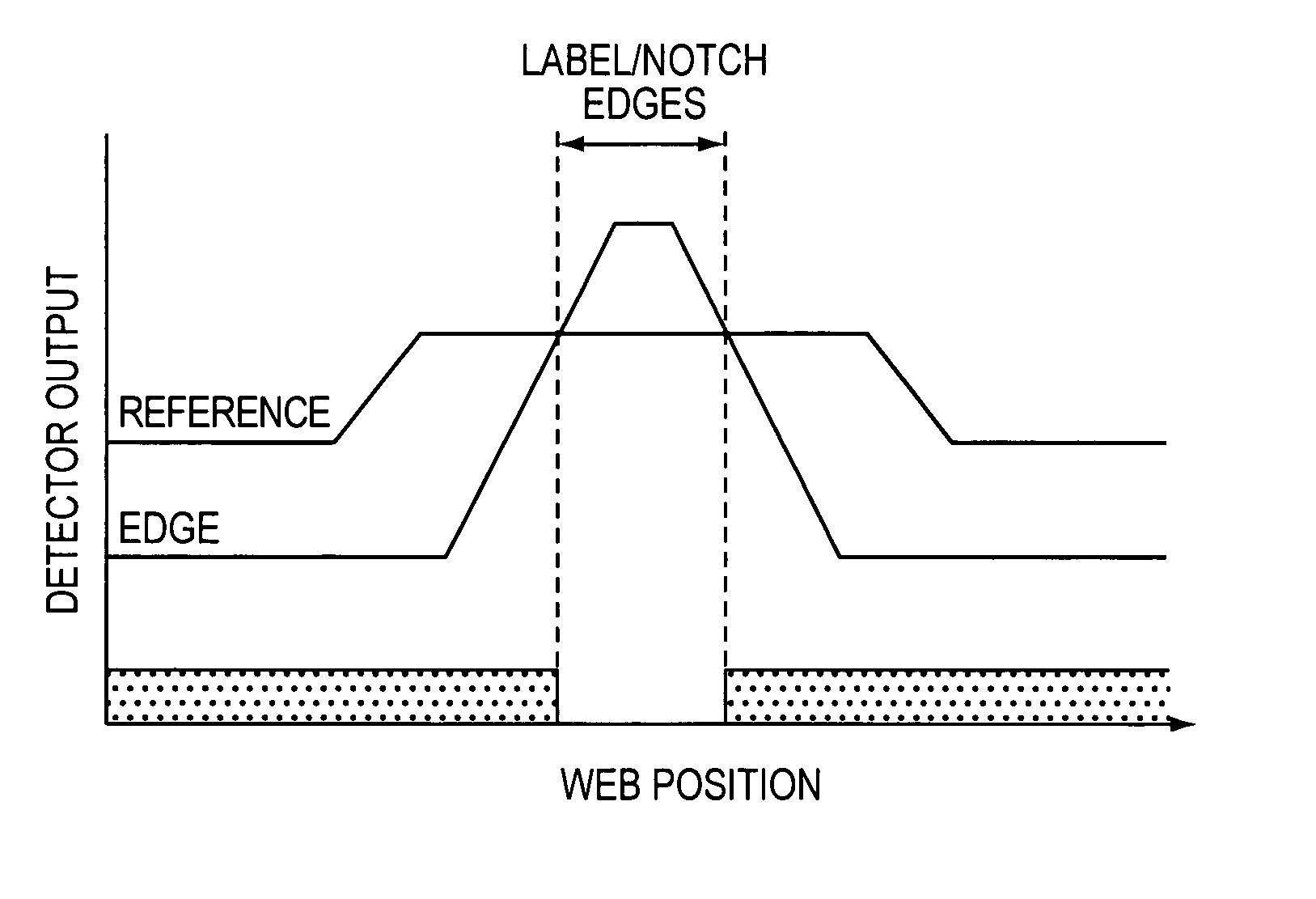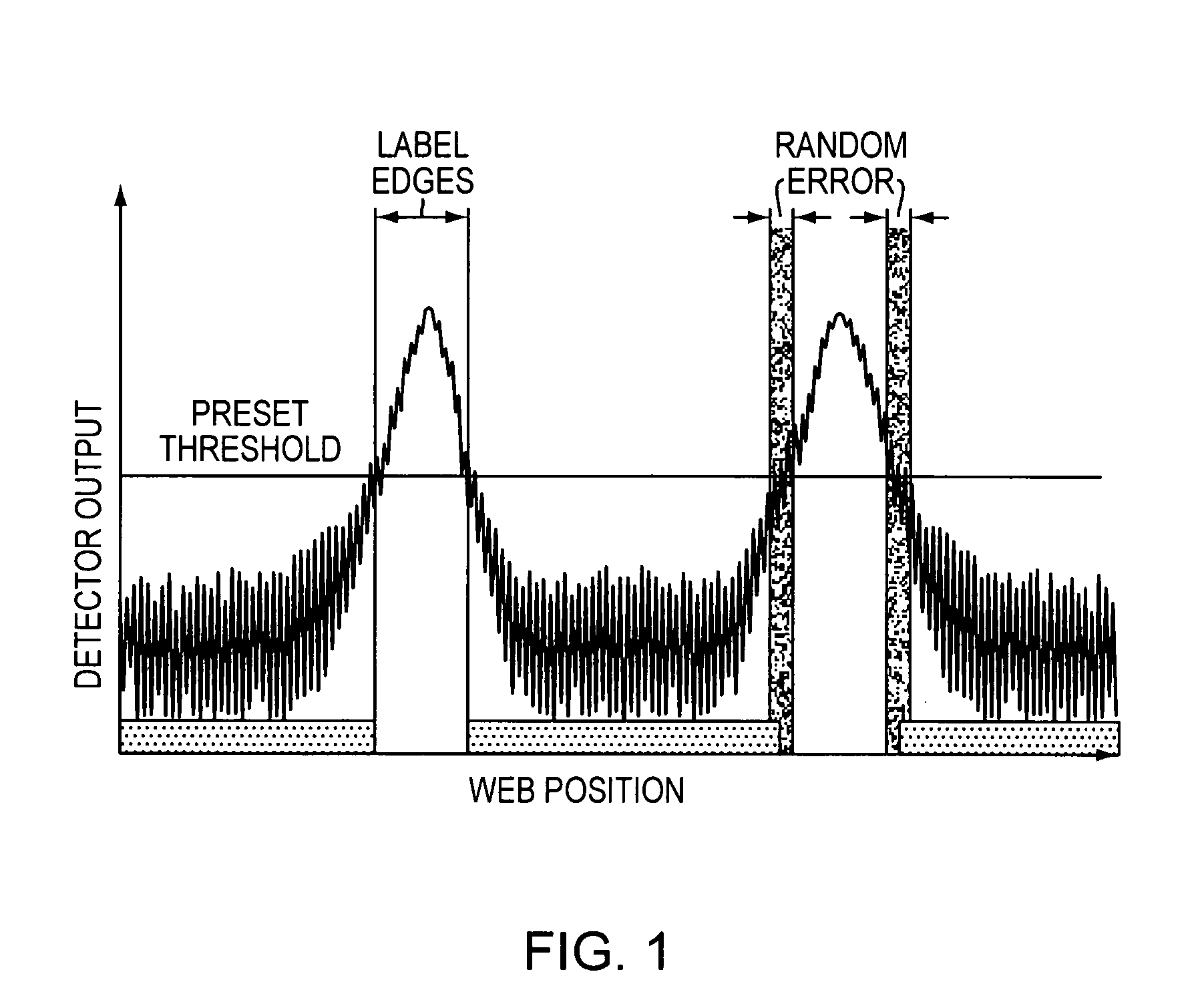Self calibrating media edge sensor
a sensor and edge technology, applied in the field of media sensors, can solve the problems of degrading the response characteristics of the sensor circuit, affecting and reducing the random error of the signal response, so as to reduce the effect of ambient ligh
- Summary
- Abstract
- Description
- Claims
- Application Information
AI Technical Summary
Benefits of technology
Problems solved by technology
Method used
Image
Examples
first embodiment
[0041] the invention uses an energy emitter that illuminates, through the media, a reference sensor 2 and an edge sensor 4. A simplified electrical schematic of the sensor circuit is shown in FIG. 2. The reference sensor 2 and the edge sensor 4 sense the first emitter 6 output passing through the web between each label. The output of each sensor is input to a comparator 8 that switches state when the edge signal level exceeds the reference signal level. To ensure that the steady state “high” reference signal level is below the edge signal “high” level, a bias may be introduced via modifications to the aperture dimensions and or adjusting components. In one embodiment, as illustrated in FIG. 2, the bias may be introduced by adjusting a pair of pull-down resistor values so that R1 is larger than R2. More generally, however, the bias can be introduced in a variety of ways including deliberate sensor mismatching, differences in corresponding parts (e.g., pull-down resistor values, etc.)...
second embodiment
[0045] the invention is selectable between dual modes. In a first mode, the circuit operates as described above, monitoring web transmissivity changes resulting from spaces between labels. In a second mode, the circuit monitors web reflectivity changes resulting from passage of black mark(s) 20 placed on the back side of the web. As shown in FIG. 8A, to add the second mode, a second emitter 18 is located proximate the edge sensor 2 and the reference sensor 4 to illuminate the sensor side of the web 13. If closed loop feedback is used for the first emitter 6 supply current level as described herein above, the second emitter 18 may be similarly configured.
third embodiment
[0046] the invention includes a “reflective-only” version. As shown in FIG. 8B, this embodiment does not require the presence of the emitter 6. Thus, rather than being selectable between dual modes, the circuit need only be configured to monitor web reflectivity changes resulting from the passage of black mark(s) 20 placed on the back side of the web. To do so, the emitter 18, as shown in FIG. 8B, is located proximate the edge sensor 2 and the reference sensor 4 to illuminate the sensor side of the web 13. As with the other embodiments, closed loop feedback can be used for the emitter 18 supply current level as described herein above.
[0047] With the circuit in black mark detecting mode, the first emitter 6 is disabled and the second emitter 18 is energized. As shown by the signal level progression in FIG. 9, the circuit operates with an inverted steady state as both the reference sensor 2 and the edge sensor 4 receive the second emitter 18 output reflection from the web, causing ele...
PUM
 Login to View More
Login to View More Abstract
Description
Claims
Application Information
 Login to View More
Login to View More - R&D
- Intellectual Property
- Life Sciences
- Materials
- Tech Scout
- Unparalleled Data Quality
- Higher Quality Content
- 60% Fewer Hallucinations
Browse by: Latest US Patents, China's latest patents, Technical Efficacy Thesaurus, Application Domain, Technology Topic, Popular Technical Reports.
© 2025 PatSnap. All rights reserved.Legal|Privacy policy|Modern Slavery Act Transparency Statement|Sitemap|About US| Contact US: help@patsnap.com



